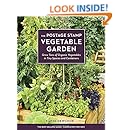
This classic gardening bestseller (over 500,000 copies sold) uses
ecologically friendly, intensive biodynamic methods to produce large
amounts of vegetables in very tiny spaces. Revised for an all new
generation of gardeners, the 40th anniversary edition includes brand new
information on the variety of heirloom vegetables available today and
how to grow them the postage stamp way.
To accommodate today's lifestyles, a garden needs to fit easily into a
very small plot, take as little time as possible to maintain, require a
minimum amount of water, and still produce prolifically. That's exactly
what a postage stamp garden does. Postage stamp gardens are as little as
4 by 4 feet, and, after the initial soil preparation, they require very
little extra work to produce a tremendous amount of vegetables--for
instance, a 5-by-5-foot bed will produce a minimum of 200 pounds of
vegetables.
When first published 40 years ago, the postage stamp techniques, including closely planted beds rather than rows, vines and trailing plants grown vertically to free up space, and intercropping, were groundbreaking. Now, in an ever busier world, the postage stamp intensive gardening method continues to be invaluable for gardeners who wish to weed, water, and work a whole lot less yet produce so much more.
When first published 40 years ago, the postage stamp techniques, including closely planted beds rather than rows, vines and trailing plants grown vertically to free up space, and intercropping, were groundbreaking. Now, in an ever busier world, the postage stamp intensive gardening method continues to be invaluable for gardeners who wish to weed, water, and work a whole lot less yet produce so much more.
About the Author
Karen Newcomb has contributed to and co-written eight
gardening books with her late husband, Duane. She is a lifetime
vegetable gardener, garden blogger, and avid writer, and has been a
writing teacher for more than twenty years. She lives in Rocklin,
California.
When this book was first published in
1975, these concepts were unusual and revolutionary in the home garden.
Since that time, there have been many imitators and variations, but the
postage stamp method has stood the test of time. With more than half a
million copies sold, this book has helped people of all gardening levels
successfully grow many more vegetables in very tiny spaces.
This new edition is fully revised and now contains information on heirloom seed varieties. Heirloom varieties not only produce excellent results, but you can also save the seeds for the next season to guarantee the same vegetable as the parent plant. Because heirloom vegetables are living artifacts of history, these old-time varieties offer a glimpse of earlier times when vegetables were known and grown for their flavor.
The Postage Stamp Vegetable Garden offers simple, easy techniques that work. I hope you will try the postage stamp methods in your garden, and then experiment on your own. Get ready to plant. Whether you plant hybrid varieties or grow heirlooms, you will soon be able to enjoy the fruits of your labor.
This new edition is fully revised and now contains information on heirloom seed varieties. Heirloom varieties not only produce excellent results, but you can also save the seeds for the next season to guarantee the same vegetable as the parent plant. Because heirloom vegetables are living artifacts of history, these old-time varieties offer a glimpse of earlier times when vegetables were known and grown for their flavor.
The Postage Stamp Vegetable Garden offers simple, easy techniques that work. I hope you will try the postage stamp methods in your garden, and then experiment on your own. Get ready to plant. Whether you plant hybrid varieties or grow heirlooms, you will soon be able to enjoy the fruits of your labor.

I'm trying to teach my home schooled daughter about growing fruits and
vegetables this year. However since we have a tiny yard I'm looking for
all the help I can get. This book has a lot of good pointers and how
to-s that I'm looking forward to implementing. I am also hopeful that my
daughter will turn out to have a green thumb and enjoy gardening. I
enjoyed reading this book and I have recommended it to my friends as
well.
As a blogger companies sometimes provide me with samples of their products, and in this case, Blogging for Books provided me with their The Postage Stamp Vegetable Garden: Grow Tons of Organic Vegetables in Tiny Spaces and Containers to test and review and to give my honest opinion of the results
As a blogger companies sometimes provide me with samples of their products, and in this case, Blogging for Books provided me with their The Postage Stamp Vegetable Garden: Grow Tons of Organic Vegetables in Tiny Spaces and Containers to test and review and to give my honest opinion of the results
No comments:
Post a Comment